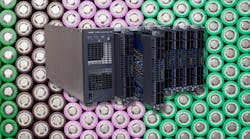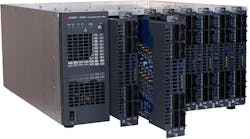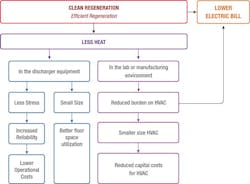Balancing Power Usage During Battery-Cell Test
What you'll learn:
- Employing regeneration during discharge rather than dissipating energy as heat.
- What is the balance point?
- Should the operator take active measures to maintain operation at the balance point?
Charging and discharging batteries is an energy-intensive process. During cell manufacturing, a high-volume factory might produce 1 million cells per day, creating enormous demand for electrical power during charging and releasing most of that energy during discharging.
When characterizing cells, a lifecycle test may be used to cyclically charge and discharge cells for hundreds or thousands of cycles. Consequently, it consumes electrical power during each charge step and releases it again during the discharge step—all of which adds up over those large numbers of cycles. That’s why regions rich in low-cost, renewable energy (wind, hydro, solar) are natural homes to cell factories and cell development.
There’s no escaping the need to consume electrical power to charge, but what about during discharge? Historically, when cells were discharged, the excess energy would just be dissipated as heat into an electronic load or a simple resistor bank. In this case, the discharging electrical power would be 100% wasted. Even worse, the heat generated would need to be managed by a cooling system or HVAC to take the waste heat away from the machinery, operators, and test equipment.
Getting Greener Through Regeneration
In modern charge/discharge systems for cell formation or cell cycling, equipment manufacturers “go green” (Fig. 1). Rather than taking the discharge electrical energy and wastefully converting it to heat, these new systems can regenerate. They take the discharge electrical energy and convert it back to ac power that can be put back on the ac line and utilized by other electrical consumers.
1. Keysight’s BT2200 regenerative charger/discharger for cell formation or cell cycling offers up to 75% efficient regeneration when discharging 256 cells at 6 A or from 16 cells at 100 A.
Though the process isn’t perfectly efficient, typically you can recover 70% to 90% of the electrical power coming from the discharging cells. This power can be used to provide energy to charging cycles and, thus, recycle the energy. If 75% efficiency is attained, then only 25% of the energy will go to waste heat. While this is waste, it’s a significant improvement over dissipating all of the energy as heat.
The reduction of excess heat into the test environment means that HVAC systems are less stressed and therefore can be sized smaller and run using less energy. Furthermore, less excess heat means less heat is generated inside of the discharging equipment, which has benefits of less heat stress on the equipment, resulting in smaller-sized equipment and higher reliability (Fig. 2).
2. The flow chart illustrates relationships between regeneration, heat reduction, benefits, and savings.
Food for thought: When dissipating the energy as heat, you can consider this to be 0% efficient regeneration.
How to Make AC Regeneration Work
As this is an article about charging and discharging, let’s consider how to use the energy from the discharging cells to provide energy to the charging cells. It’s made possible by ac regeneration, as the ac power from the discharging cells is put back on the ac line so that it can be taken off the ac line and used by the charging circuits.
In an ideal world, a balance point can be struck where all energy for charging is supplied by the discharging cells. In effect, the energy is locally recycled. As such, no energy would flow back out onto the grid and the system would be energy-neutral.
Since the regeneration from the discharging cells will have efficiencies of about 75%, it will typically take more cells discharging than charging to hit that balance point. Of course, if more cells were being charged than discharged, power would need to flow from the ac line to cover the excess power requirements of the charging cells. If many more cells were being discharged than charged, the surplus of power would flow back out onto the grid.
So, should a balance point be sought after as the “best place” to operate? If so, should the system operator take active measures to maintain operation at the balance point? My answer is no.
The Balance Point
Let’s take the example of a testing lab that plans to cycle large numbers of cells every day. At any moment, many cells will be charging and consuming ac power while numerous others are discharging and supplying ac power. Energy neutrality, where the system is balanced, will only happen when the right charging and discharging ratios are achieved to maintain the balance, perhaps by some smart supervisory software system that monitors and enforces the charging and discharging ratios.
Now, in this lab, the system is in balance and a test engineer comes along needing to cycle one more cell on an empty channel in the cell cycler. If the first step of the cycle is charge, this addition of the cell will increase demand on energy into the system, and the balance will no longer exist. If the balance was to be maintained and enforced by the smart supervisory software, the system would prompt the engineer to hold off on starting a new cycle test until more discharge energy was available.
Imagine a system refusing to accept the next cell to be tested! I believe this would create a very unpleasant user experience, have a negative effect on lab test output productivity, and be wasteful of the test system’s unused channel assets, which would sit idle until the balance could be re-attained.
Taken to the extreme, if only a few cells are discharging, then only a few cells could be charging, and the remainder of the system will sit idle. Thus, forcing the system to operate at a balance point, which is always shifting as the charge/discharge ratios change, means the system will have a very unpredictable utilization.
In manufacturing, where processes are predictable and cells will run as a continuous flow, it’s possible to setup the manufacturing line to run near the energy-neutral balance point. Cell and process variations would make it impossible to always stay at the balance point, but staying near it is feasible. Enforcing the system to operate at the balance point would mean restricting the material flow to manipulate the ratios of charging to discharging cells. In a cell factory, manufacturing throughput is paramount and no cell producer would want to negatively impact throughput by restricting material flow.
Conclusion
Regeneration is a highly desirable feature of charging/discharging equipment used in cell formation and cell cycling. The energy recovered from discharging cells can greatly offset the energy costs needed to charge cells. Additional benefits come with reduction of waste heat, lessening the burden on the HVAC as well as allowing for smaller, more reliable discharging systems.
However, actively trying to balance charging and discharging will require supervisory software that ultimately limits when you can request more charging or more discharging based on ever-changing operating conditions. Also, most test engineers want systems that don’t limit when testing can be done.


